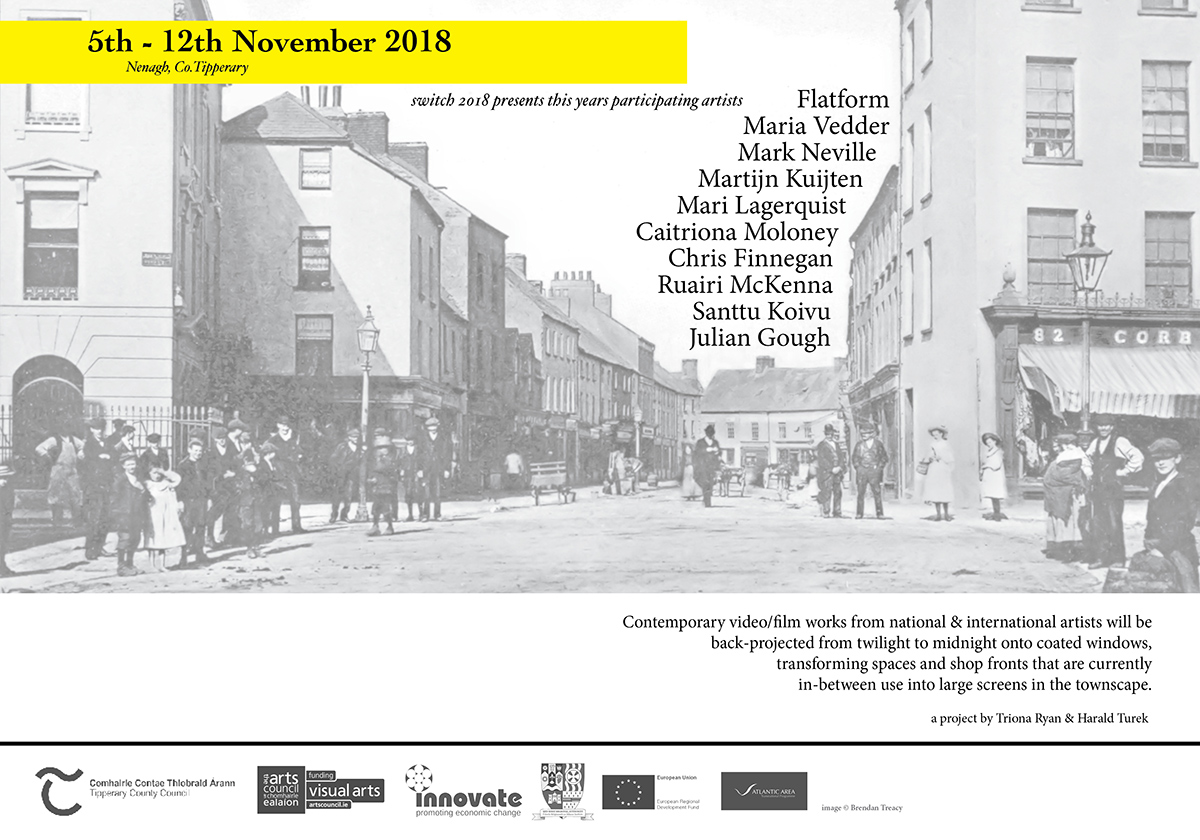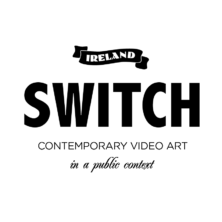
Nenagh
What do you do, when your home town, the town you grew up in, doesn’t feel like home? Well, one option is, process your feelings through art. Sing your way out of it. Write your way out of it. Dream your way out of it. And, of course, leave.
But then what do you do, decades later, when an artist from that town – Nenagh – asks you to write something about the place, for the wonderful SWITCH visual arts festival, which is holding its tenth anniversary there this week?
You process your feelings through writing.
And back in time you tumble…
My Tipperary parents met and married in London; and so I spent my first seven years living a few hundred yards from the end of Heathrow Airport’s main runway. Concorde’s test flights rattled my toy cars off the windowsill. My playgrounds were multiethnic; my teachers wore mini-skirts; the British Museum was a tube ride away.
And then my family moved back to Tipperary, to Nenagh, where my accent, my name, my existence, generated, in teachers and students alike, peculiar republican antibodies. I was firmly rejected. Having been rejected, I rejected back. The graft never really took.
So my relationship with Nenagh is… complicated. But then, Nenagh’s relationship with itself is complicated. Nenagh started as a thirteenth century Norman settlement, built on the site of an ancient regional fair, in a fiercely independent landscape of warrior-farmers. The entire town ceased to exist in the 14th century – it just faded away; everybody left; perhaps they all became artists – and so they had to start the town up again from scratch in the 16th century. That Nenagh was burnt down in 1550, by O’Carroll. And burnt down again in 1688 by Patrick Sarsfield. Despite this (or perhaps because of this – maybe some inhabitants had the same ambiguous feelings I have for the town), Sarsfield managed to get a street named after him, after they’d rebuilt the place yet again. Of course, Sarsfield Street is also Pound Street, because no street in Nenagh has a settled name. When I grew up, Kenyon Street was called, half the time, by half the people, Barrack Street. Connolly Street was more frequently Silver Street. Mitchell Street was, if you weren’t careful, Queen Street. (Appropriately stark choices of name, those, for the street where Sonny O’Neill went first to lie low, and then to spend the rest of his life, after shooting Michael Collins). And Main Street was Pearse Street was Castle Street, depending on the age and politics and mood of the person you talked to. If ambiguity is at the heart of art, Nenagh was a fine incubator for artists.
Nenagh even managed to have a dysfunctional but artistic relationship with its own river. The Nenagh river ran, not quite through, but around the eastern edge of the town proper. It was almost as though it was avoiding the town – and, given the way it was treated, you wouldn’t blame it. On some days, when I was a child, the river ran a pure white, as the creamery washed its tanks, or dumped milk that had failed inspections. On other days, the river ran a deep, dark red, as the abattoir cleansed itself of a week’s accumulated blood. It wasn’t just the river water which the town transformed into ambiguous public art: years after I left, the Johnson & Johnson factory leaked chemicals into the town’s groundwater, and for a year the stuff that came out of the taps was a strongly smelling Oil of Olay eau de toilette. A daring piece of conceptual art, worthy of the Venice Biennale.
But the real artists dropped out of school early, to work in the abattoir. Day after day, with stun gun and flensing knife – and long prefiguring Damian Hirst – they carved from cow and calf masterpiece after masterpiece for export to the Middle East.
If you hung around the Market Cross too long after school, the lads would emerge from the dark of the abattoir with pockets they had thoughtfully filled with cows’ eyeballs. Anyone they felt was getting a bit above themselves had a fair chance of being hit by a flying eyeball from across the street. “Getting above yourself” was a broad, flexibly-defined crime that included reading a book, and wearing glasses. (In this they were perhaps ironically referencing Pol Pot’s Cambodia.)
The impulse behind this practical criticism was almost affectionate. “Better you know now there’s no place for that nonsense in this world”, said each flying eyeball as it bounced off your book, “than you go out into the world unprepared. Those books, which come from elsewhere, from un-Nenagh, have no understanding of the true truth of life.”
I realised, when I finally encountered the literary world many years later, that the eyeballs had a point.
Nenagh didn’t have a cinema, because some kids had – in the great tradition of O’Carroll and Sarsfield – burnt it down a few years earlier, allegedly during a matinée that had gotten out of hand; but, years later, I saw the beautiful, disturbing, art films of Louis Buñuel. In one, a woman’s eyeball is sliced open by a razor – Buñuel and Dalí pulled off that shot with, yes, a cow’s eyeball – in another, a middle class group sit around a table, on toilets, calmly chatting and shitting, but then creep away to a tiny room, embarrassed, to eat. Oh, I thought, yes, I recognise this world. He is making films about Nenagh. He, too, grew up in Nenagh.
I became a writer, an artist – whatever you want to call it – in Nenagh. Not Galway, where I later studied English literature and philosophy. Not Berlin, where I studied life, and art. Nenagh.
There are huge advantages to growing up in a town that has no tradition at all of knowingly creating original art in any medium. There is tremendous freedom. With my best friend, Kevin McGee, I edited and wrote the first magazine in our school’s history (it was banned after one issue). With Kevin, too, I set up the first group in the town’s history that wrote its own songs. (We were banned after our first gig.) I wrote my first science fiction short story as homework (and received a reprimand, and zero out of ten, from my Christian Brother English teacher, for not writing a conventional essay.) When I told my career guidance teacher I wanted to be a pop star in my twenties, then a novelist in my thirties, she told me I was mentally ill. This was all very invigorating. Encouragement is greatly overrated. What you need is resistance; texture; something to write about, to wrestle with. Like the lads in the meat plant, you need something to process, and Nenagh gave me that.
But that Nenagh is now gone, as is that Ireland; as is that angry young version of me. The virus of art finally broke Nenagh’s resistance, and swept through the place and the people, transformed them. The new Nenagh has an Arts Centre. An Arts Festival. A Heritage Centre. Regular art exhibitions. A cinema, intact, unburned! You can get a great cappuccino, in one of half a dozen excellent cafés. The principal and vice principal of my primary school have both finally been jailed, for the usual offences. Kevin McGee went on to become a magnificent playwright, and one of the top writers on the national soap opera, Fair City (If you’ve ever laughed hard at an episode, it was one of his). Donal Ryan has immortalised the place, and shown Nenagh its face (thinly, very thinly, disguised) in a series of masterpieces. Half the town are now artists, in some way or another. My own mother now paints, publishes poetry, has written a novel. My father has been making sculptures for decades now. Nenagh’s population (8,968!) is the highest it has ever been, in its eight hundred year history. It even has foreigners, and likes them! The playgrounds are multiethnic. The young Poles and old Irish chat on the church steps each Sunday. The grafts are taking. This weird, dramatic (oh, I haven’t told you the half of it), complicated, ambiguous town has found a place in the modern world.
For years I was so angry with the place I wouldn’t mention Nenagh’s name, in my work or in interviews, for fear the town would benefit somehow from the mention. Now I can say, Nenagh made me. I owe it my personality, such as it is. I owe it the career that I love. I owe it, ultimately, my happiness.
It’s great to see SWITCH lighting up the windows of Nenagh again this year, for the tenth time, for a magical week, throwing modern art from all over the world out onto the streets where the cows’ eyeballs once bounced like grenades; ambiguous gifts, from one group of artists to another.
We’re all in this together, now.
SWITCH runs in Nenagh from November 5th to November 12th
Julian Gough’s latest novel is Connect. His latest children’s book is Rabbit & Bear: Attack of the Snack.
